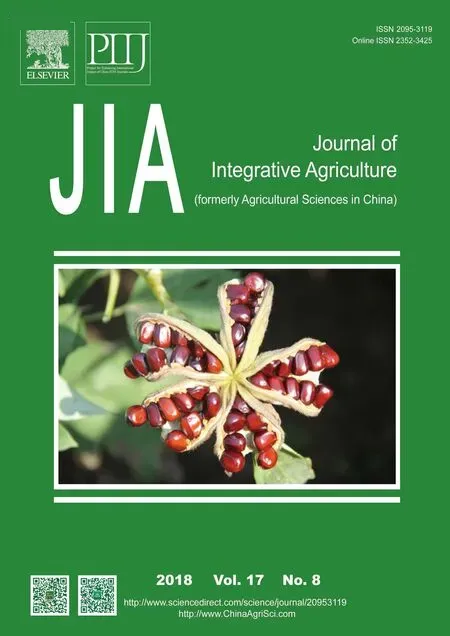First report of cereal cyst nematode (Heterodera filipjevi) on winter wheat in Shandong Province, China
ZHEN Hao-yang , PENG Huan , ZHAO Hong-hai, QI Yong-hong, HUANG Wen-kun KONG Ling-anLIANG Chen, WEN Yan-hua, PENG De-liang
1 State Key Laboratory for Biology of Plant Diseases and Insect Pests, Institute of Plant Protection, Chinese Academy of Agricultural Sciences, Beijing 100193, P.R.China
2 College of Agronomy, South China Agricultural University, Guangzhou 510642, P.R.China
3 Key Laboratory of Integrated Crop Pest Managements of Shandong Province, College of Plant Health and Medicine, Qingdao Agricultural University, Qingdao 266109, P.R.China
4 Institute of Plant Protection, Gansu Academy of Agricultural Sciences, Lanzhou 730070, P.R.China
The cereal cyst nematodes (Heterodera avenae,Heterodera filipjevi,Heterodera latipons) are considered to be one of the most important plant parasitic nematodes attacking most cereals and can cause significant crop losses (Sikora 1988). In China,H. filipjevi(Madzhidov 1981) Stelter, 1984, was first reported from Henan province (penget al. 2010) and a few years later in Anhui province and Xinjiang Uygur Autonomous Region (penget al. 2016, 2018) . In December 2017, a survey for cereal cyst nematodes on winter wheat was conducted in Shandong Province, China. A total of 79 samples that including roots and rhizosphere soil were collected. Cysts and second-stage juveniles (J2s) were isolated from each soil sample using the sieving-decanting method. Wheat roots were stained with acid fusion to observe the development of cereal cyst nematodes.One sample collected from Yangzhuan Village in Huanggang Town, Shan County of Heze City (GPS 34°38´23.10´´N,116°05´42.95´´E), Shandong Province, was found that the wheat roots were heavily parasitized by cyst nematodes, and most of the nematodes in roots had developed to fourth-stage (J4) in mid-December of 2017. The morphological and molecular studies of cyst and J2s were carried out to confirm the identification ofH.filipjeviin one winter wheat field soil and root sample from Shan County. The cysts were lemon shaped with prominent vulval cone, brown to black in colour. Cuticle with irregular zig-zag pattern. Neck prominent, vulval cone bifenestrate with horseshoe-shaped fenestra, bullae and underbridge strongly developed. The main morphometrics of cysts (n=8) were length (including neck) (688 to 948 µm, mean=794 µm,standard deviation=87 µm), width (465 to 620 µm, mean=529 µm, standard deviation=63 µm), neck length (71.5 to 126.3 µm,mean=86.5 µm, standard deviation=9.2 µm), fenestra length (43.8 to 71.3 µm, mean=58.0 µm, standard deviation=15.1 µm),fenestra width (19.8 to 32.0 µm, mean=25.0 µm, standard deviation=3.9 µm), length of vulval slit (8.1 to 9.7 µm, mean=9.1µm, standard deviation=0.5 µm) and length of underbridge (64.5 to 101.3 µm, mean=82.6 µm, standard deviation=12.8µm). Measurements of J2s (n=10); body length (556.7 to 617.0 µm, mean=584.3 µm, standard deviation=23.2 µm); stylet(22.8 to 24.1 µm, mean=23.3 µm, standard deviation=0.4 µm), tail (59.6 to 68.6 µm, mean=65.8 µm, standard deviation=3.5 µm) and hyaline tail terminus (35.9 to 41.1 µm, mean=38.6 µm, standard deviation=2.1 µm).Genomic DNA was isolated from single cysts (n=6), and the internal transcribed spacer regions were amplified with primers TW81 (5´-GTTTCCGTAGGTGAACCTGC-3´) and AB28 (5´-ATATGCTTAAGTTCAGCGGGT-3´) (Joyceet al.1994) and 28S rDNA-D2/D3 regions were amplified with primers D2A (5´-ACAAGTACCGTGAGGGAAAGTTG-3´)and D3B (5´-TCGGAAGGAACCAGCTACTA-3´) (Subbotinet al. 2006). The obtained internal transcribed spacer regions(ITSs) sequences (GenBank accession MG859977) is 99%identical to those ofH.filipjevi from Turkey (KR704292.1 and KR704304.1), the United States (KP878490.1 and GU079654.1) and China (KY448473.1 and KY448473.1).The obtained 28S rDNA-D2/D3 sequences (GenBank accession MG859980) also to be 99 to 100% identical to those ofH.filipjevifrom China (GU083597.1, KT314235.1,GU083592.1). The species-specific primers ofH.filipjevi(HfF1, 5´-CAGGACGAAACTCATTCAACCAA-3´; HfR1,5´-AGGGCGAACAGGAGAAGATTAGA-3´) were also used to identify this population (penget al. 2013), the specific band was obtained species-specific primers ofH. filipjevi.Based on the morphological and molecular data, the species of the cyst-forming nematode was identified asH.filipjevi.
As far as we know, this is the first report ofH.filipjeviin Shandong Province, China. The population density ofH.filipjeviwere found much higher than those of other CCN,it can serious infect winter wheat at seedling stage which often cause economically damaging to wheat, so the spread ofH.filipjeviwould be a risk for the cereal production of Shandong province.
This study was financially supported by the National Natural Sciences Foundation of China (31571988) and the Special Fund for Agro-scientific Research in the Public Interest, China (201503114).
 Journal of Integrative Agriculture2018年8期
Journal of Integrative Agriculture2018年8期
- Journal of Integrative Agriculture的其它文章
- Is the “One Province One Rate” premium policy reasonable for Chinese crop insurance? The case in Jilin Province
- What determines irrigation efficiency when farmers face extreme weather events? A field survey of the major wheat producing regions in China
- lmpacts of invasive Iris pseudacorus L. (yellow flag) establishing in an abandoned urban pond on native semi-wetland vegetation
- Changes in soil biochemical indicators at different wheat growth stages under conservation-based sustainable intensification of rice-wheat system
- Accumulation and bioavailability of heavy metals in a soil-wheat/maize system with long-term sewage sludge amendments
- Effects of long-term green manure application on the content and structure of dissolved organic matter in red paddy soil
